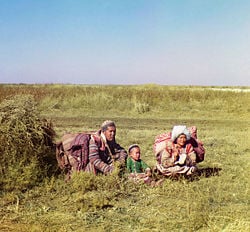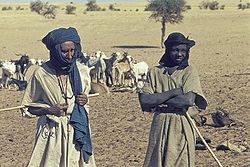Nomadic people, also known as nomads, are communities of people that move from one place to another, rather than settling down in one location. Nomadism is distinguished from migration, which involves a major and permanent move from one location to another. Nomads, on the other hand, move periodically or cyclically, usually returning to their original location at various times.
There are three kinds of nomads: hunter-gatherers, pastoral nomads, and peripatetic nomads. Nomadic hunter-gatherers are probably the original lifestyle of most indigenous people. They subsist harvesting seasonally available wild plants and game. Pastoralists raise herds and move with them so as not to deplete pasture beyond recovery in any one area. Peripatetic nomads are more common in industrialized nations traveling from place to place offering a trade wherever they go.
There are an estimated 30-40 million nomads in the world today. Many cultures were traditionally nomadic, but the development of modern agriculture, industrialization, and national borders has changed their lifestyle. Nomadism has become a minority lifestyle for modern people. Those who dwell in stable fixed societies often look at nomadic people with suspicion. Nomadic people have historically developed strong ties within their communities, creating a strong sense of identity which enabled their culture to survive despite numerous interactions with others. Today, however, nomads of all kinds are facing problems in preserving their cultural heritage. As human achievements have advanced in recent times, bringing all people into greater contact with each other, the nomadic lifestyle has become endangered. Yet, those who continue to live this way often have knowledge and traditions that are of value to humankind as a whole. Efforts to preserve and include these in world-wide understanding have been initiated.
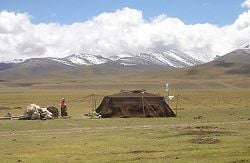
History of nomadic peoples
The nomadic hunter-gatherer society appears to have been the earliest type of human society. Most such cultures are extinct today, with only a few tribes still living this type of lifestyle. As human societies developed, different lifestyles emerged, many of them sedentary, rather than nomadic. On every continent, where societies developed suitable agriculture, there began a competition for the land. Eventually the nomadic peoples were forced to move, became acculturated, and changed their lifestyles. The alternative was destruction.
In northern Europe, when various kingdoms began to be established the nomadic people became known as "barbarian," the enemies of more "civilized" societies. In China, the nomadic people became the rulers and settled down. In the Americas, native peoples had various conflicts among themselves, and then faced a large immigrant population that practiced ownership of land and property, rather than a simpler "use ownership." Those who practiced ownership of land dominated those who did not, in many cases destroying their nomadic ways of life. Africa has had these situations, but many indigenous nomadic people utilized land that no one else knew how to work and many were able to preserve their heritage fairly well. Some examples of nomadic people of the past are described below.
Eurasian Avars
The Eurasian Avars were a nomadic people of Eurasia, supposedly of proto-Mongolian Turkic stock, who migrated from eastern Asia into central and eastern Europe in the sixth century. Avars were driven westward when the Gokturks defeated the Hephthalites in the 550s and the 560s. They entered Europe in the sixth century and, having been bought off by the Eastern Emperor Justinian I, pushed north into Germany (as Attila the Hun had done a century before).
Finding the country unsuited to their nomadic lifestyle (and the Franks stern opponents), they turned their attention to the Pannonian plain, which was then being contested by two Germanic tribes, the Lombards and the Gepids. Siding with the Lombards, they destroyed the Gepids in 567 and established a state in the Danube River area. Their harassment soon (ca. 568) forced the Lombards into northern Italy, a migration that marked the last Germanic migration in the Migrations Period. By the early ninth century, internal discord and the external pressure started to undermine the Avar state. The Avars were finally liquidated during the 810s by the Franks under Charlemagne and the First Bulgarian Empire under Krum.
Hephthalites
The Hephthalites, also known as "White Huns," were an Indo-European and quite possibly an Eastern Iranian nomadic people. The term Hephthalite derives from Greek, supposedly a rendering of Hayathelite (from the term Haital meaning "Big/Powerful" in the dialect of Bukhara), the name used by Persian writers to refer to a sixth century empire on the northern and eastern periphery of their land.
The Hephthalite lived across western China, Central Asia, Afghanistan, Pakistan, and northwest India in the fourth through sixth centuries. They had no cities or system of writing, lived in felt tents, and practiced polyandry. As a group they appear to be distinct from the Huns who ravaged Europe in the fourth century.
Native Americans
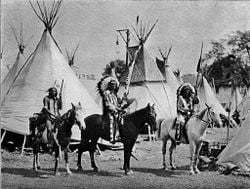
The indigenous peoples of the Americas are the pre-Columbian inhabitants of the continent. In some regions they created large sedentary chiefdom polities, while in others they were nomadic. The Canadian natives were mostly nomadic, living in small bands and subsisting off hunting and gathering style industries.[1] In the North American plains area, several different peoples shared traits of nomadic hunter-gatherers primarily based on buffalo hunting. In South America too, many areas were populated by nomadic people. By the time the first European explorers arrived in Brazil, all parts of the territory were inhabited by semi-nomadic Indian tribes, who subsisted on a combination of hunting, fishing, gathering, and agriculture.
The European invasion of the Americas forever changed the lives, bloodlines, and cultures of the peoples of the continent. Their populations were ravaged by disease, by the privations of displacement, and in many cases by warfare with European groups that may have tried to enslave them. The first contact with the Europeans was disastrous for the natives. Explorers and traders brought European diseases, such as smallpox, which killed the populations of entire villages. Although many South American natives succumbed to massacres, diseases, and the hardships of slavery and displacement, many were absorbed into the European immigrant population.
In North America, after the American Revolutionary War, the indigenous peoples in what became the United States found themselves at the mercy of a government and people that saw the American lands as their own. Native tribes were continuously pushed farther and farther inland. In the mid and late nineteenth century, the explicit policy of Indian Removal forced or coerced the relocation of major Native American groups in both the Southeast and the Northeast United States, resulting directly and indirectly in the deaths of tens of thousands. The subsequent process of assimilation was no less devastating to Native American peoples. Tribes were generally located to reservations on which they could more easily be separated from traditional life and pushed into European-American society. For many, whose lifestyle had been connected to that of the buffalo who roamed freely in great herds across the plains, as the buffalo disappeared almost into extinction so did the native tribes. Survival required giving up their nomadic lifestyle.
Wu Hu
Wu Hu (Chinese: äșèĄ; pinyin: WÇ HĂș; literally "Five Hu") is a collective term for various non-Chinese steppe tribes during the period from the Han Dynasty (206 B.C.E. -22 C.E.) to the Northern Dynasties. These nomadic tribes originally resided outside China proper, but gradually migrated into Chinese areas during the years of turmoil between the Eastern Han Dynasty and Three Kingdoms. These non-Chinese tribes, whom the Han had fought to a standstill, seized the opportunity afforded by the weakness of the central government to extend their settlement of pastoral lands into the fertile North China Plain.
The Rebellion of the Eight Kings during the Western Jin Dynasty triggered a large scale Wu Hu uprising from 304, which resulted in the sacking of the Chinese capitals at Luoyang (311) and Chang'an. The Xiongnu Kingdom of Han-Former Zhao captured and executed the last two Jin emperors as the Western Jin Dynasty collapsed in 317. Many Chinese fled to the south of Yangtze River as numerous tribesmen of the Wu Hu and remnants of the Jin wreaked havoc in the north. Fu JiÄn temporarily unified the north but his brilliant achievement was destroyed after the Battle of Feishui. The Northern Wei Dynasty unified northern China again in 439 and ushered in the period of the Northern Dynasties.
Hunter gatherers
The hunter-gatherer lifestyle naturally imposes a certain amount of nomadism on those who practice it. However, this may be simply daily movements through the local environment, or it may involve seasonal travels to different habitats. Thus, where resources are abundant or where it is possible to store food and other supplies, the people may remain within a relatively small area. Generally, nomadic hunter gatherers are organized in small bands that develop great familiarity with their territory.
There are few true hunter gatherer societies remaining in the world. Many Native Americans and Indigenous Australians were nomadic prior to Western contact. However, their survival required alterations to their lifestyle as they were forced to live in reservations too small to support nomadism. Some can still be found in remote areas, places where the ecology remains pristine and political divisions are large enough to contain traditional areas that can sustain their lifestyle. Examples of indigenous nomadic peoples, some of whom continue to live a nomadic lifestyle, include tribes in Africa, Northern Europe, and Northern parts of North America.
Bushmen
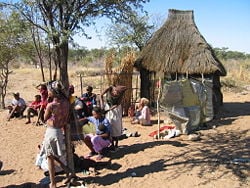
The Bushmen, also known as the Khwe Khoe, Basarwa, San, or the !Kung, are nomadic peoples of Southern Africa. It is believed that they have lived there for 22,000 or more years. Their population today is estimated at 82,000. They are traditional hunter gatherers, with a unique language consisting of click consonants.
During the 1970s, with their land increasingly encroached and taken by the government for game reserves and cattle ranches, many gave in and abandoned their wandering lifestyle. Instead, they began to raise cattle in semipermanent villages.
Innu
The Innu are the indigenous inhabitants of eastern Québec and Labrador, Canada. They are known to have lived on these lands as hunter-gatherers for several thousand years, living in tents made of animal skins. Their subsistence activities were historically centered on hunting and trapping caribou, moose, deer, and small game. Their population in 2003 includes about 18,000 persons, of which 15,000 live in Québec.
The Innu people are frequently sub-divided into two groups, the Montagnais who live along the north shore of the Gulf of Saint Lawrence, in Québec, and the less numerous Naskapi ("inland people") who live farther north. The Naskapi are traditionally nomadic peoples, in contrast with the territorial Montagnais. The Innu themselves recognize several distinctions based on different regional affiliations and various dialects of the Innu language.
Pygmies
Pygmies are nomadic peoples living in the equatorial rainforests of central Africa, with smaller numbers in south-east Asia. They are characterized by their short height (below 1.5 meters, or 4.5 feet, on average). They prefer their specific ethnic names, such as Baka or Mbuti, rather than the generic "pygmy." They are found in the Republic of Congo, Cameroon, northern Congo, northern Gabon, and the southwestern Central African Republic. The Asian Negrito inhabit the Philippines, Malay Peninsula, and the Andaman Islands. Pygmy tribes have received much attention from anthropologists, with varied results for the different tribes.
Sami
The Sami are indigenous to an area called Sapmi, which encompasses parts of northern Sweden, Norway, Finland, and the Kola Peninsula of Russia. The Sami, who speak a language of the same name, are one of the largest indigenous groups in Europe. Their population is thought to be about 85,000.
The Sami were traditionally hunters, fishers, and reindeer herders and farmers. Only a minority of Sami still have these occupations today, with very few having a nomadic lifestyle.
Despite great pressure to change, and even destroy, Sami culture, in August of 1986, the national anthem (SĂĄmi soga lĂĄvlla) and flag (Sami flag) of the Sami people was created. In 1989, the first Sami parliament in Norway was elected. In 2005, the Finnmark Law was passed in the Norwegian parliament. This law gives the Sami parliament and the Finnmark Provincial council a joint responsibility of administering the land areas previously considered state property. These areas, 98 percent of the provincial area, that have always been used primarily by the Sami, now belong officially to the people of the province, Sami or Norwegian, and not the Norwegian state.
Pastoralists

Nomadic pastoralism is a form of agriculture where livestock (such as cattle, sheep, goats, and camels), are taken to different locations in order to find fresh pastures. It is commonly practiced in regions with little arable land, typically in the developing world. Increased enclosure and fencing of land has reduced the amount of land available for this practice. Of the estimated 30â40 million nomadic pastoralists worldwide, most are found in central Asia and the Sahel region of West Africa.
Nomadic pastoralists are often sedentary to a certain area as they move between the permanent spring, summer, autumn, and winter pastures for their livestock, moving according to the availability of resources. This pattern of movement has led some anthropologists to consider pastoral nomadism a form of transhumance.
Nomadic pastoralism seems to have developed as a part of the secondary products revolution proposed by Andrew Sherratt.[2] Sherratt suggested that early use of domestic animals for primary carcass products (meat) was broadened to include exploitation for renewable "secondary" products (milk and its associated dairy products, wool and other animal hair, hides and consequently leather, manure for fuel and fertilizer, traction, and riding/pack transport). Many of these innovations first appeared in the Near East during the fourth millennium B.C.E. and spread to Europe and the rest of Asia soon afterwards. Historically, nomadic herder lifestyles led to warrior based cultures, fearsome enemies of settled people.
Nomadic pastoralism is thought to have developed along with population growth and an increase in the complexity of social organization. Karim Sadr[3] has proposed the following stages:
- Pastoralism: A mixed economy with a symbiosis within the family.
- Agropastoralism: Where there is symbiosis between segments or clans within an ethnic group.
- True Nomadism: When symbiosis is at the regional level, generally between specialized nomadic and agricultural populations.
Bakhtiari
The Bakhtiari (or Bakhtiyari) are a group of southwestern Iranian people. They primarily inhabit the provinces of Lorestan, Khuzestan, Chahar Mahaal and Bakhtiari, and Isfahan. In Iranian mythology, the Bakhtiari consider themselves to be descendants of Fereydun, a legendary hero from the Persian national epic, Shahnameh.
A small percentage of Bakhtiari are still nomadic pastoralists, migrating between summer quarters (yaylÄq, ÙÙÙۧÙ) and winter quarters (qishlÄq, ÙŰŽÙۧÙ). Numerical estimates of their total population widely vary. Many significant Iranian politicians and dignitaries are of Bakhtiari origin.
Bedouin
Bedouin means desert-dweller, and they live in the Sahara, Sinai, and the eastern coast of the Arabian Desert. The term applies mainly to Arabs but occasionally to non-Arab groups such as the Beja of the African Coast of the Red Sea. It is difficult to determine the actual number of Bedouin living today because they consist of many different tribes and many have become acculturated to the rest of society throughout the Middle East.
Bedouin populations are increasingly giving up their nomadic lifestyles and moving closer towards the cities in the Middle East region. This is mostly because of environmental conditions, such as droughts and a loss of grazing ranges. The government has also had a desire to move these people into settlements in order to better assist them with education, healthcare, and the like.
Fulani
The Fulani are the largest nomadic group of people in the world and have played an influential role in politics, economics, and religion throughout Western Africa for over a thousand years. Historically, the Fulani played a significant role in the rise and fall of ancient African empires such as the Ghana Empire, the Mali Empire, Songhai, and the Mossi states.
They follow a code of behavior known as Pulaaku, consisting of the qualities of patience, self control, discipline, prudence, modesty, respect for others (including foes), wisdom, forethought, personal responsibility, hospitality, courage, and hard work. The Fulani were the first group of West Africans to convert to Islam, and they played a principal role in the spread of Islam throughout West Africa.
The Fulani herd cattle, goats, and sheep and in the modern world have developed a broader variety of social and economic patterns. Those who continue more exclusively in the pastoral tradition today enjoy greater prestige within their society than those who do not.
Kuchis (Kochai)
Kuchis are a tribe of Pashtun nomads in Afghanistan. They represent an estimated six million of Afghanistan's 25 million people. Until the late twentieth century, the Kuchis practiced seasonal migration, with their sheep, goats, and camels they spent summer in the highlands and winter in the lower elevations. In the 1970s, the government offered land to the Kuchis in Northern Afghanistan. This was the territory of mostly Uzbeks and Tajiks. Some Kuchis accepted and became farmers and semi-nomadic herders. This relocation, however, was not entirely pleasant. Many of the Uzbeks and the Tajiks resented the Kuchis for encroaching on their land. In addition to this cultural confrontation, the war with the Soviet Union in the 1980s and the civil war among the Mujahideen factions in the 1990s caused upheaval for the Kuchis. Many could no longer sustain their nomadic lifestyles. Additionally, severe droughts from 1998-2002 made it nearly impossible for the Kuchis to live as they once did.
Kyrgyz

The Kyrgyz, a Turkic people, comprise 69.5 percent of the population of contemporary Kyrgyzstan. They have historically been semi-nomadic herders, living in round tents called yurts and tending sheep, horses, and yaks.
The population became increasingly urbanized after World War II, but some families continued to take their herds of horses and cows to the high mountain pasture (jailoo) every summer. Since the 1990s, as the cash economy shrunk, unemployed relatives were absorbed back on the family farm, and the importance of this form of nomadism has increased. The symbols of nomadism, specifically the crown of the grey felt tent known as the yurt, appears on the national flag, emphasizing the centrality of their nomadic history and past in the creation of the modern nation of Kyrgyzstan. The retention of this nomadic heritage and the freedoms that it assumes continue to have an impact on the political atmosphere in the country.
Moken
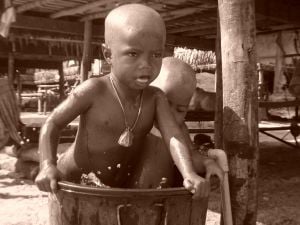
The Moken (sometimes called "Sea Gypsies," Thai: àžĄàžàčàžàž; also called Salone or Salong) are an ethnic group with about 2,000 to 3,000 members who maintain a nomadic, sea-based culture. Their Malayo-Polynesian language is originally from Malaya and likely immigrated to the Myanmar and Thailand areas from China 4,000 years ago.
Their knowledge of the sea enables them to live off its organisms by using simple tools such as nets and spears to forage for food. What is not consumed is dried atop their boats, and then used for trade at local markets for other necessities. During the monsoon season, they build additional boats while occupying temporary huts. Many of the Burmese Moken are still nomadic people who roam the sea most of their lives in small hand-crafted wooden boats called Kabang, which serve not just as transportation, but also as kitchen, bedroom, and living area. Unfortunately much of their traditional life, built on the premise of life as outsiders, is under threat and appears to be diminishing.
The Burmese and Thai governments have made attempts at assimilating the people into their own culture, but these efforts have failed. The Thai Moken have permanently settled in villages located on two islands: Phuket and Phi Phi. Those islands received much media attention in 2005 during the Southeast Asia Tsunami, where hundreds of thousands of lives were lost in the disaster. The Moken's knowledge of the sea managed to spare all but one of their lives - one of an elderly, handicapped man. However, their settlements and about one-fifth of their boats were destroyed.
Nenets
The Nenets are a group of nomads who are indigenous to Russia. They speak their own language, Nenets, and an early twenty-first century census revealed that there were 41,302 in the Russian Federation.
After the Russian Revolution of 1917, their culture suffered due to Soviet collectivization policy. The government of the Soviet Union tried to force the nomads to settle down, and most of them became assimilated. They were forced to settle on permanent farms and their children were educated in state boarding schools, leading to an erosion of their cultural heritage. Environmental damage due to the industrialization of their land and overgrazing of the tundra migration routes in some regions, particularly in the Yamal Peninsula, have further endangered their way of life. Those who continue their nomadic lifestyle are dependent on freedom to travel with their reindeer, but need support to preserve their language and traditions.
Tuareg
The Tuareg are a Berber ethnic group, found mostly in West Africa, but they were once nomads throughout the Sahara. The Tuareg are descendants of ancient Saharan peoples described by Herodotus. For over two millennia, the Tuareg operated the trans-Saharan caravan trade connecting the great cities on the southern edge of the Sahara to the northern (Mediterranean) coast of Africa.
The Tuareg today are found mostly in West Africa. They have been disrupted by the post colonial division of nations that divided them between the nations of Niger, Burkina Faso, Libya, Mali, and Algeria. The 1990s brought much warfare and strife for them with various resolutions in the different nations.
Many Tuareg have settled into the communities with which they traded, serving as local merchants and representatives for their friends and family who continued to trade. Some Tuareg farm or herd animals on areas designated as homelands by their national governments, resembling the Native American Indian Reservations in the United States. Some "settlement" areas are more like refugee camps, especially in areas with vague regulations or unresolved contention with the Tuareg. Some have abandoned farming and herding, and seeking jobs in towns and cities, melding into the urban culture.
Peripatic Nomads
Another kind of nomadism, called peripatetic nomadism, involves those who move from place to place offering a specific trade. Peripatetic nomads are commonly found in industrialized nations. One large and well known group of peripatetic nomads are the Roma or "gypsies."
Pavee
The Pavee, also called Irish Travellers, are a nomadic or itinerant people of Irish origin living in Ireland, Great Britain, and the United States. An estimated 25,000 Travellers live in Ireland, 15,000 in Great Britain, and 10,000 in the United States. They are distinguished from the settled communities by their customs and Shelta language, although they also speak English but with a distinct accent and mannerisms.
Travellers have dwelt in Ireland since at least the Middle Ages, and may have descended from another nomadic people called the Tarish. They have traditionally traveled in caravans, and may offer various services to their neighbors such as tin working or as handymen. They have a few animals they travel with, such as goats who provide milk and meat. Some places in Europe provide places like camp grounds where they can stay, and some are changing their lifestyle by simply remaining in these camps. They have benefited from education and improved medical care, but some also feel they must merge more with the dominant culture as they feel shut out in this middle ground. The Shelta language is dying out and only the older Travellers still know the language completely.
Roma
The Roma are a nomadic ethnic group who are found in Southern and Eastern Europe, Western Asia, Latin America, the southern part of the United States, and the Middle East. They are believed to have originated on the Indian subcontinent. The term "gypsy" is also used to refer to these people. "Gypsy" has also been misunderstood to mean a type of lifestyle, rather than the ethnic group that it actually describes.
Roma people, particularly in Eastern Europe, often live in depressed squatter communities, with very high unemployment, while only some are fully integrated in the society. However, in some casesânotably the Kalderash clan in Romania, who work as traditional coppersmithsâthey have prospered. Although some Roma still embrace a nomadic lifestyle, much of their migration is actually forced, as most communities do not accept Roma settlements.
The Roma have numbers today in the range of 8 to 10 million. There are four main divisions of Roma, based on territorial, cultural, and dialectal differences. These are the Kalderash, Gitanos, Sinti, and the Romnichal.
Kalderash
The Kalderash are one of the largest groups within the Roma people. Their name means "cauldron builder." They were traditionally smiths and metal workers, skilled in bronze and gold work. Many Roma living in Romania have the surname "Caldararu," which means they or their ancestors belonged to this clan or satra as it is known in their language. As their traditional crafts become less profitable, they are trying to find new ways of coping, and are facing difficulties assimilating, as education is not a priority within the culture.
Gitanos
The Gitanos are a Roma people that live in Spain, Portugal, and southern France. In southern France they are known as Gitans or more generally Tziganes (includes the other French Roma) and in Portugal they are known as Ciganos.
Gitanos are said to never use a whip on a horse, mule, or donkey. As a result, they have a reputation as excellent horse-trainers. In the late 1980s, the gitanos lived predominantly in southern and central Spain. Many of them took up a sedentary form of life, working as junk collectors, street vendors, or entertainers, as well as stealing and committing other petty crimes. Poor and largely illiterate, they have never been integrated into Spanish society.
Sinti
Sinti or Sinta is the name of some communities of the Roma. This includes communities known in German and Dutch as Zigeuner and in Italian as Zingari. While the Sinti were, until quite recently, chiefly nomadic, today only a small percentage of the group remains unsettled. In earlier times, they frequently lived on the outskirts of communities, generally in squalor.
The Sinti have produced a great number of renowned musicians, such as jazz guitarist Django Reinhardt. Titi Winterstein and several members of Reinhardt's clan still play traditional and modern "Gypsy jazz" all over Europe. The Sinto HĂ€ns'che Weiss produced a recording in Germany in the 1970s in which he sang about the Poraimos (Roma Holocaust) in his own language. Many younger Germans first learned about this part of The Holocaust history as a result of this recording. The jazz keyboardist Joe Zawinul was also of Sinte descent.
Romnichal
Romnichal or Romanichal is a neologism by which groups of Roma people found in some parts of the United Kingdom, notably England, refer to themselves in their own language, Anglo-Romany. The name is not universally accepted by English Roma, who will often call themselves "Romany Folk." They are thought to have arrived in Britain in the sixteenth century and were descendants of the Illes clan of Eastern Hungary.
Traditionally, Romnichals earned a living doing agricultural work and would move to the edges of towns for the winter months. There was casual work available on farms throughout the spring, summer, and autumn months, and would start with seed sowing, planting potatoes and fruit trees in the spring, weeding in early summer, and there would be a succession of harvests of crops from summer to late autumn. Of particular significance was the hop industry, which employed thousands of Romnichals both in spring for vine training and for the harvest in early autumn. Winter months were often spent doing casual labor in towns or selling goods or services door to door.
Mass industrialization of agriculture in the 1960s led to the disappearance of many of the casual farm jobs Romnichals had traditionally carried out. This, and legislation aimed at stopping travelers camping on common land and roadsides, has forced large numbers of Romnichals to abandon their nomadic lifestyle and take on a sedentary existence.[4]
Originally, Romnichals would travel on foot, or with light, horse-drawn carts, and they would build "bender" tents where they settled for a time. A bender is type of tent constructed from a frame of bent hazel branches (hazel is chosen for its straightness and flexibility), covered with canvas or tarpaulin. Around the mid to late-nineteenth century, Romnichals started using wagons that incorporated living spaces on the inside. These they called Vardos, and they were often brightly and colorfully decorated on the inside and outside. In the present day, Romnichals are more likely to live in caravans.
Nomads in the twenty-first century
Nomadism declined severely in the twentieth century, for both economic and political reasons. Industrialization, developments in systematic and mechanized agriculture, and the attitudes of societies that viewed nomadism as incompatible with modern society were all contributing factors.
The hunter-gatherer societies have fared the worst among nomadic people in their protection from politically dominant groups overwhelming their culture. Although the development of formal agriculture is generally linked to the development of technology and more universal prosperity, other viewpoints advocate the protection of nomadic lifestyle. One reason includes the potential future contribution in the area of advanced tribal knowledge of complex ecologies, such as the rainforest. Science has not yet de-coded all the mysteries of such an environment, and we still learn much from the traditional inhabitants of these regions particularly in medicinal and other usages of plants. Their knowledge is from a collective experience rather than a formal, conscious, intellectual source and as such affords the possibility of unique discoveries perhaps otherwise inaccessible.
In the Amazonian rainforest, local law usually protects indigenous hunter gatherers. However, settlers want access to natural resources such as the gold in the Amazonian region or simply land to raise crops. The sectoring of farm plots endangers the nomadic lifestyle, because both hunter-gatherers and peripatetics need large free range areas, which are no longer available with the smaller farms dividing the area. Even when governments have designated areas for indigenous use, people have ignored these laws and there are too few police to enforce them. Failure of local law enforcement to see the purpose of protecting native peoples increases the problem.
Where indigenous people have learned about the other, dominant culture and gained access to it, policies are often negotiated with more benefit to nomadic peoples. The most successful areas include good partnership with advocate who have membership in the dominant society and can also advocate their cause from within the dominant society. In areas where this has not happened, and few or ineffective advocates from the dominant culture have appeared, the situation is often quite grim.
The earliest efforts for native peoples to give up various aspects of their culture has been modified a great deal, particularly as native people have gone through the religious education and received various ordinations and recognition within the religion of the dominant people. There is now a widespread movement to reclaim the indigenous culture, and in the late twentieth and early twenty-first centuries, this has a relatively cooperative relationship with many Christian denominations and their missionaries.
Current nomadic people may utilize multiple approaches within their culture, usually within a tribal or communal structure. Almost all have universally welcomed different strategies to medicines. Many today are educated in universities of the dominant society and utilize modern technology. In the Sahara and the Gobi deserts, herders often use portable generators to see DVD movies or receive satellite television. Many are partially nomadic, and are partially utilizing other local resources for income, generally agricultural.
Notes
- â Olive Patricia Dickason, A Concise History of Canada's First Nations (Oxford University Press 2006 ISBN 0195424158)
- â Andrew Sherratt, "Plough and pastoralism: aspects of the secondary products revolution" Pattern of the Past: Studies in the Honour of David Clarke. (Cambridge University Press, 1981, ISBN 978-0521227636)
- â Karim Sadr. The Development of Nomadism in Ancient Northeast Africa. (University of Pennsylvania Press, 1991, ISBN 0812230663)
- â Romany History, BBC Kent Romany Roots. Retrieved May 31, 2008.
ReferencesISBN links support NWE through referral fees
- Chatty, Dawn. Mobile Pastoralists. Columbia University Press, 1996. ISBN 978-0231105491
- Churchill, Ward. A Little Matter of Genocide. City Lights Books, 1997. ISBN 0872863239
- Deleuze, Gilles and FĂ©lix Guattari. A Thousand Plateaus. University of Minnesota Press, 1987. ISBN 978-0816614028
- Dickason, Olive Patricia. A Concise History of Canada's First Nations. Oxford University Press, 2006. ISBN 0195424158
- Fraser, Angus. The Gypsies. Oxford: Blackwell Publishers, 1992. ISBN 0631159673
- Grousset, René. L'Empire des Steppes. Payot, (original 1939) 2001. ISBN 978-2228881302
- Hodder, Ian, Glynn Isaac, and Norman Hammond (eds.). Pattern of the Past: Studies in the Honour of David Clarke. Cambridge University Press, 1981. ISBN 978-0521227636
- Isaacson, Rupert. The Healing Land: The Bushmen and the Kalahari Desert. Grove Press, 2004. ISBN 0802140513
- Sadr, Karim. The Development of Nomadism in Ancient Northeast Africa. University of Pennsylvania Press, 1991. ISBN 0812230663
External links
All links retrieved July 23, 2025.
- ProjectMaje.org - Burma "Sea Gypsies" Compendium
- Official website of the Innu Nation of Labrador.
- Official website of the Naskapi Nation of Kawawachikamach, Québec
- Virtual Museum of Canada - Tipatshimuna: Innu stories from the land
- Canada's Tibet: The Killing of the Innu, a report from Survival International (PDF file) (A study of Innu communities of Labrador)
- Montagnais Indians (Quebec) - Article in the Catholic Encyclopedia
- Pavee Point Traveller and Roma Centre
Credits
New World Encyclopedia writers and editors rewrote and completed the Wikipedia article in accordance with New World Encyclopedia standards. This article abides by terms of the Creative Commons CC-by-sa 3.0 License (CC-by-sa), which may be used and disseminated with proper attribution. Credit is due under the terms of this license that can reference both the New World Encyclopedia contributors and the selfless volunteer contributors of the Wikimedia Foundation. To cite this article click here for a list of acceptable citing formats.The history of earlier contributions by wikipedians is accessible to researchers here:
- Nomad history
- Moken history
- Innu history
- Wu_Hu history
- Irish_Traveller history
- Nomadic_pastoralism history
The history of this article since it was imported to New World Encyclopedia:
Note: Some restrictions may apply to use of individual images which are separately licensed.
